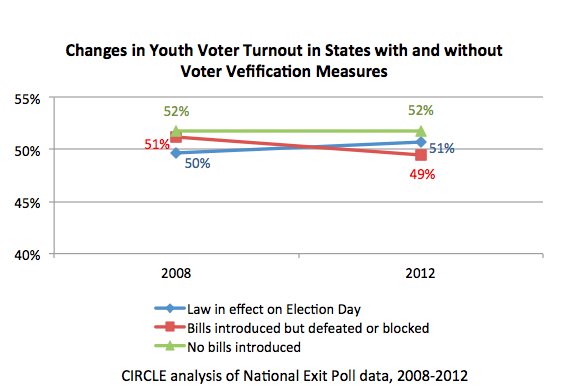Did New State Voting Laws Affect the Youth Vote in 2012?
The 2012 election was marked by new legislation that could make voting more difficult—a total of 25 new laws were in effect on Election Day in 19 states—and by organized challenges to the new laws, which we call “pushback.”
The Brennan Center for Social Justice reports that, since the beginning of 2011, a total of 180 bills were introduced in 41 states to require photo ID, proof of citizenship for voting, or to shorten the periods when citizens can register or vote early. These bills were controversial, with proponents arguing that they were needed to prevent fraud, and critics asserting that they would block eligible citizens, especially minority youth, from voting. The critics responded by contesting the constitutionality of the new laws in federal courts. The Department of Justice joined in some of the challenges, governors vetoed bills in some states, and voting rights groups worked on the ground to educate and mobilize voters, sometimes citing the laws to encourage voting.
Before the election, no one could know the effect of the legislation or the pushback. Our pre-election polls showed that young people were misinformed about the laws. Now, preliminary turnout statistics provide some evidence of the impact on actual voting.
CIRCLE has used the exit poll data from the 2008 and 2012 presidential elections to estimate aggregate youth turnout for three groups of states. One group of states had new legislation in place on Election Day. A second group saw bills introduced but ended up with no new laws in effect on Election Day. In the third group of states, no new legislation was introduced. The table below shows which states were in each group, and also includes the numbers of bills introduced in each state, as well as the number of pushback actions in response to these bills.
Overall, the new voter ID and other laws do not seem to have affected youth turnout by a significant amount. The chart below shows that there were essentially no notable changes in turnout for any of the groups, although youth turnout declined slightly in the states where new laws were proposed but ended up being blocked (51% to 49%).
This is not to say that the efforts to challenge the laws were ineffective or unnecessary. The pushback may have successfully countered the impact of the legislation. Some even propose that the legislative debates motivated some voters to come out to vote.
We also examined whether the overall political balance of the states (i.e., Blue states vs. Red states) had any relationship to the change. We found that differences in turnout between 2008 and 2012 were unrelated to the presidential choice of the states (analysis not shown).
Many other factors influence youth turnout, and isolating the effects of voting laws will require more evidence. Furthermore, this preliminary research does not address the impact of these laws and pushback efforts on sub-groups of youth such as African Americans, Latinos, or youth of lower socioeconomic backgrounds. CIRCLE is currently fielding a large survey of young adults that will provide additional information and allow us to conduct more in-depth analysis, but until then, our preliminary analysis shows that either the new laws had modest impact or that the efforts to combat them paid off.

+ For the number of measures, we added 1 for each legislation introduced in each state. The types of legislations we counted were photo ID laws, proof of citizenship requirements, limits to registrations, and reduction in early voting periods. Many of these measures were overturned or held up in court and not in effect on Election Day.
++Pushback actions were also described and tallied in the Brennan Center’s report and included gubernatorial vetoes, Department of Justice lawsuits, challenge via court cases, and voter mobilization efforts.







November 28th, 2012 at 4:48 pm
The voter ID law was not in effect in Wisconsin.
http://www.washingtonpost.com/blogs/post-politics/wp/2012/09/27/8271/
But then since I live in Wisconsin, I already know that!
Ditto for Pennsylvania.
http://www.huffingtonpost.com/2012/11/06/pennsylvania-voter-id_n_2083626.html
December 4th, 2012 at 8:42 am
Hi Paul,
Thanks for your comment! For this, our data didn’t just track Photo ID laws – we tracked any new voter ID efforts, proof of citizenship, changes to voter registration, and changes to early or absentee voting. In Wisconsin there were new restrictions on Voter Registration that were in effect in that state during this election cycle.
For PA, we had to make a bit of a judgement call, but per Brennan center, photo ID law was passed, so that the voters would be “requested” to show ID.
December 13th, 2012 at 12:40 pm
[…] are true, but the libertarian is–appropriately–concerned about principles. By analogy, we have found that the number of eligible citizens who were blocked from voting by photo ID laws was almost […]
September 1st, 2013 at 7:42 pm
Hey,
The Photo ID Law was NOT in effect in Texas on November 2012. It will be for Municipal elections this year though. Please let me know if you need any more information about that.
m